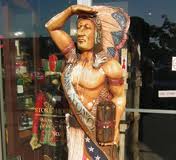Want to learn more about the cigar store Indian sculpture? Read on for facts and info about this iconic statue from American history…
The cigar store Indian sculpture is an iconic statue from the early American history. The wooden Indian statue or the cigar store Indian’s image was utilized by tobacco shops as a signpost to guide people to the shop and identify themselves as tobacco sellers.
This unique icon goes far back to the times when the early colonies in America were being developed throughout the North and South. Old world artisans would migrate to this new country and bring with them the crafts and skills which were utilized to create the shop figures. These figures are today known as the wooden Indian or a cigar store Indian statue.
Tobacco is endemic to North and South America and the culture of smoking was recorded more than 2000 years ago in the Mayan Indian culture. With the influx of mine Indians into the Aztec empire, this tradition was transferred to North American Indian tribes over the centuries. In fact Christopher Columbus is known to identify the Indians and the Caribbean with America’s smoking rolled paper filled with tobacco.
Many legends were created about smoking heads which are basically native Indians smoking cigars and tobacco in other forms. By the mid-1500s tobacco was an extremely precious tradable commodity across the world. As the consumption and propagation of tobacco grew across Europe so did the commonality of smoking. As Europe colonized the world and exploited natural resources from each region of the world, the major contribution from the Americas was tobacco. Tobacco is grown across the US and in fact was cultivated extensively in Virginia. As the Indians became more submissive to the colonists and the conflicts between the native Indians and colonists subsided, the main focus shifted towards agricultural and industrial development which resulted in massive production of tobacco crops.
Advent Of The Historical Woodcarvings And The Indian Statue
As tobacco use became mainstream it was traded on a global platform and even purchased locally. Many brands unique to the manufacturer and retailer were being sold in the market. However, native Indians were not amalgamated into mainstream culture and society and there were language barriers amongst the colonists and the natives. This is the primary reason that the Indian cigar man statue was utilized by retailers to identify them selves as a tobacco store. By the early 16th century professional wood carvings evolved from medieval times and were now reminiscent of realism to a high degree. No longer were the statues reminiscent of native Indians in the basic form but a lot more detail and time was spent in creating these classic pieces. Initially, small size statues were placed at countertops to advertise the fact that Indian tobacco was sold at a particular outlet. Since the majority of the cultivation was in Virginia these statues were called Virginians and were depicted with headdresses and kilts created out of the leaves of the tobacco plant. Thus in its countertop form or life-size version the Indian cigar man was actually a visual emblem advertising the availability of prime quality Indian tobacco at a particular retail store.





